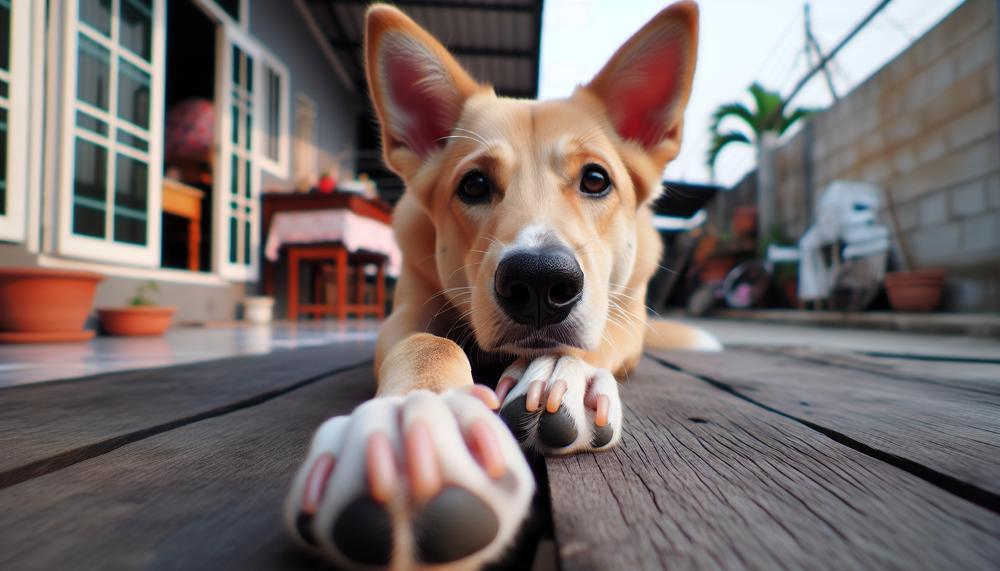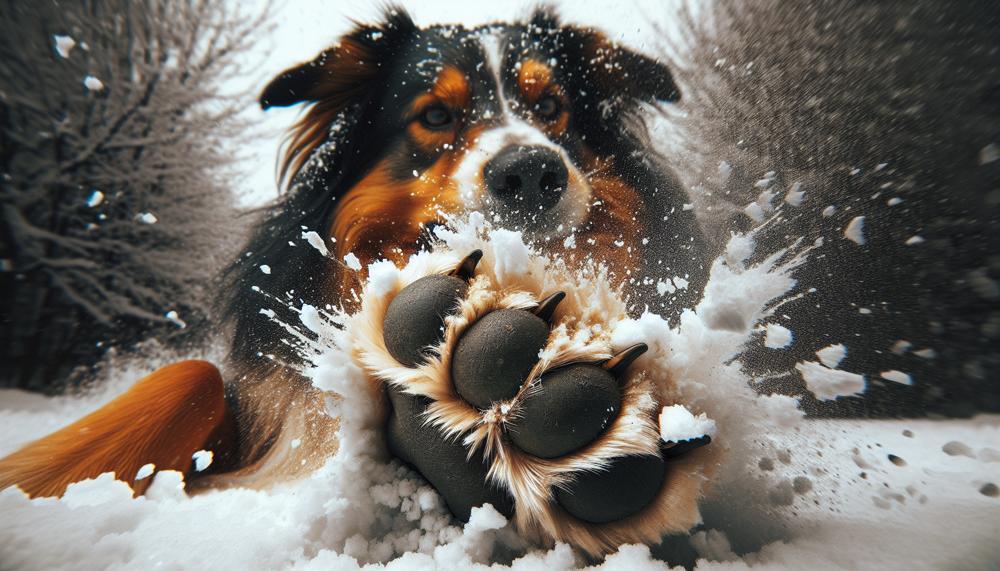Have you ever found yourself flinching as your four-legged companion playfully swats at you with their paw? Or perhaps you’ve been on the receiving end of a not-so-subtle tap from your dog’s paw when they want your attention. While it may seem like an innocent gesture, there could be more to it than meets the eye.
In this blog post, we will delve into the intriguing question of why dogs hit their owners with their paws. From playful antics to subtle communication cues, there are various explanations for this common canine behavior. So grab a treat for your furry friend and get ready to explore the fascinating world of doggy pawing.
Here are some key points that we will cover in this post:
- The playful nature of dogs and their desire for attention
- Communication through body language and pawing as a form of expression
- Instinctual behaviors inherited from their wolf ancestors
- Possible underlying medical issues that may cause excessive pawing
- Training tips for managing and redirecting this behavior
Get ready to gain a deeper understanding of your beloved pup’s actions and learn how to strengthen your bond with them. Let’s dive in.
Why does my dog hit me with its paw?
Table of Contents
Pawing is a common behavior in dogs and can stem from various reasons. As dog owners, it is crucial to pay attention to our furry companions’ body language and the context in which they paw to understand the underlying reason. Positive reinforcement training methods should be used to address any problematic pawing behaviors while setting boundaries and teaching alternative behaviors, such as shaking, can help prevent excessive pawing.
While there are many reasons why a dog may paw at their owner, it is essential to note that this behavior can also be a sign of an underlying issue. For example, if a dog is constantly pawing at their owner and showing other signs of discomfort, it could indicate pain or discomfort.
| No. | Reason | Description |
| 1 | Attention-seeking behavior | Dogs may use their paws to seek attention from their owners or to initiate playtime. |
| 2 | Hunger or desire for food | Pawing can also be a way for dogs to communicate their hunger or craving for food to their owners. |
| 3 | Previous reinforcement of the behavior | If a dog has been rewarded in the past for pawing, they may continue to do it as a way to get what they want. |
| 4 | Trained behavior | In some cases, dogs may have been trained by their owners to paw as a command or trick. |
| 5 | Affection and love | Dogs may use their paws to show affection and love towards their owners, similar to how children seek attention from their parents. |
| 6 | Sense of their owner’s emotions | Dogs are highly attuned to their owner’s emotions and may paw at them when they sense that they are feeling upset or stressed. |
| 7 | Pain or discomfort | In some cases, dogs may paw at their owners as a way to communicate pain or discomfort, such as an injury or illness. |
| 8 | Anxiety and fear | Fearful and anxious dogs may use their paws to seek reassurance or comfort from their owners. |
| 9 | Communication | Pawing can also be a way for dogs to communicate their needs or wants, such as wanting to go outside or asking for attention. |
why your dog hits you with its paw
These include seeking attention, communicating desires or emotions, expressing affection, indicating pain, or displaying dominance.
As dog owners, it is crucial to be aware of these potential motivations and address any problematic pawing behaviors through positive reinforcement training. Here are seven common reasons why your dog may hit you with its paw:
- Attention-seeking: Dogs are social creatures and crave attention from their owners. If your dog hits you with its paw, it could be seeking your attention or trying to initiate playtime.
- Communication: Dogs use body language as a way to communicate with their owners. Pawing can be a way for them to express their desires, such as wanting food, water, or a walk.
- Affection: Some dogs may show their affection towards their owners by using their paws. This behavior can also be seen as a way of reciprocating the petting or affection they receive from their owners.
- Pain: In some cases, pawing can be a sign that the dog is in pain or discomfort. If your dog suddenly starts hitting you with its paw, it is essential to pay attention and check for any signs of injury or illness.
- Past training: If your dog has been rewarded in the past for pawing at you, they may continue this behavior as a way of getting what they want. It is crucial to avoid reinforcing pawing with rewards and instead redirect this behavior towards more appropriate ways of communication.
- Fear or anxiety: Fearful or anxious dogs may use pawing as a coping mechanism to deal with stressful situations or to seek comfort from their owners.
- Dominance display: In some cases, dogs may use pawing as a way to assert dominance over their owners. This behavior is more commonly seen in untrained or poorly socialized dogs and should be addressed through proper training and socialization techniques.
Is pawing a bad thing?
Pawing is a natural behavior for dogs, but it can quickly turn into a nuisance or even a danger if it becomes excessive or harmful to others. As a responsible dog owner, it is crucial to understand the motivations behind this behavior and address it through proper training and management.
The potential dangers of pawing behavior
While pawing may seem harmless, it can lead to injuries for both the dog and those around them. For example, an overexcited dog may accidentally scratch or knock over a small child or elderly person with their paws.
Additionally, excessive pawing can cause irritation and discomfort for the dog, leading to skin infections and other health issues.
Understanding the motivations behind pawing
Dogs paw for various reasons, including seeking attention, communicating desires or emotions, expressing affection, experiencing pain or discomfort, showing dominance, releasing pent-up energy, and dealing with separation anxiety.
By understanding why your dog is pawing, you can address the underlying issue and prevent potential harm.
How to address and manage pawing behavior
Positive reinforcement training is an effective approach to address and manage pawing behavior in dogs. This involves rewarding desired behaviors, such as sitting calmly rather than pawing for attention.
It is also essential to remain consistent in your training approach and not give in to the dog’s demands when they are pawing.
Seven common reasons why dogs may paw their owners
- Attention seeking: Dogs may paw at their owners to get attention.
- Communicating desires or emotions: Dogs may use their paws to communicate needs such as hunger or the need for a potty break.
- Expressing affection: Some dogs use their paws to show love and affection.
- Pain or discomfort: If a specific body part is hurting, dogs may paw at it.
- Dominance: Dogs with dominant personalities may use their paws to assert dominance over their owners or other pets.
- Boredom or excess energy: Dogs may paw as a way to release pent-up energy or boredom.
- Separation anxiety: Some dogs may paw when left alone or separated from their owners.
Tips for managing excessive pawing in dogs
To prevent excessive pawing, ensure your dog receives enough physical and mental stimulation through exercise, playtime, and training sessions.
You can also teach your dog alternative ways to communicate their needs, such as ringing a bell or going to a designated spot.
The importance of consistency in addressing pawing behavior
Consistency is crucial when addressing pawing behavior in dogs. If you give in to the dog’s demands when they are pawing, it will reinforce the behavior and make it more difficult to manage.
By remaining consistent in your training approach, you can effectively address and prevent excessive pawing.
3 tips on what to do if your dog hits you with its paw

One of the keys to maintaining a healthy relationship with your dog is training them to stop hitting you with their paw. Not only can this behavior cause harm, but it can also be a sign of underlying issues that need to be addressed.
To help you effectively train your dog not to hit you with its paw, here are three tips:
Understand the Motivation Behind the Behavior
Before diving into training your dog, it’s important to understand why they are pawing at you in the first place. While it may seem like a simple attention-seeking behavior, it could also be a sign of discomfort or pain.
Take note of your dog’s body language and consult with a veterinarian if necessary.
Use Positive Reinforcement Training
Positive reinforcement training is an effective method for teaching your dog not to hit you with its paw. Rather than scolding or punishing your dog for pawing at you, teach them a trick that involves hitting with their paw, such as high-five or shake.
This will give them an outlet for their behavior and reinforce the idea that pawing only results in positive attention.
Redirect Their Focus
If your dog starts pawing at you, redirect their focus onto something else, such as a toy or a treat. This not only prevents them from hitting you but also teaches them that they can receive attention by engaging in alternative behaviors.
With consistency and patience, your dog will learn to communicate and interact with you in a more appropriate manner.
Remember to always seek professional help if you encounter any difficulties while training your dog.
Conclusion
In conclusion, while it may seem like a playful gesture, a dog hitting their owner with their paw can have underlying meanings and should not be ignored.
By delving into the motivations behind this behavior and utilizing positive reinforcement training, we can effectively manage and redirect it.
Consistency is key in reinforcing desired behaviors, and seeking professional help when needed can also greatly benefit both the dog and their owner.






